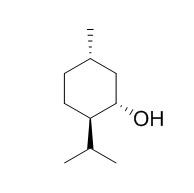D-Menthol
Menthol is a common compound in pharmaceutical and commercial products and a popular additive to cigarettes, it attenuates α7 mediated Ca 2+ transients in the cell body and neurite, suggests that menthol inhibits α7-nACh receptors in a noncompetitive manner. Menthol has cooling sensation in the skin, by chemically triggering the cold-sensitive TRPM8 receptors. Menthol has analgesic property, it acts as a noncompetitive antagonist of the 5-HT3 receptor.
Inquire / Order:
manager@chemfaces.com
Technical Inquiries:
service@chemfaces.com
Tel:
+86-27-84237783
Fax:
+86-27-84254680
Address:
1 Building, No. 83, CheCheng Rd., Wuhan Economic and Technological Development Zone, Wuhan, Hubei 430056, PRC
Providing storage is as stated on the product vial and the vial is kept tightly sealed, the product can be stored for up to
24 months(2-8C).
Wherever possible, you should prepare and use solutions on the same day. However, if you need to make up stock solutions in advance, we recommend that you store the solution as aliquots in tightly sealed vials at -20C. Generally, these will be useable for up to two weeks. Before use, and prior to opening the vial we recommend that you allow your product to equilibrate to room temperature for at least 1 hour.
Need more advice on solubility, usage and handling? Please email to: service@chemfaces.com
The packaging of the product may have turned upside down during transportation, resulting in the natural compounds adhering to the neck or cap of the vial. take the vial out of its packaging and gently shake to let the compounds fall to the bottom of the vial. for liquid products, centrifuge at 200-500 RPM to gather the liquid at the bottom of the vial. try to avoid loss or contamination during handling.
Rev. Chim.2020, 71(3),558-564
Chemistry of Plant Materials.2019, 129-136
Front Pharmacol.2021, 12:607403.
J Appl Biol Chem.2022, 65(4):pp.463-469.
Drug Invention Today2019, 12(6):1303-1306
Chemistry of Plant Raw Materials2019, 4:135-147
Ajou University2024, 4688116
Int J Mol Med.2015, 35(5):1237-45
Korean J of Crop Science2019, 452-458
Pharmaceutics.2022, 14(5):945.
Related and Featured Products
Chemosphere. 2014 Oct;113:30-5.
Effects of d-menthol stress on the growth of and microcystin release by the freshwater cyanobacterium Microcystis aeruginosa FACHB-905.[Pubmed:
25065786 ]
The effects of D-Menthol on the growth of Microcystis aeruginosa FACHB-905 and microcystin (MCY) concentration were evaluated by batch culture experiments.
METHODS AND RESULTS:
The algal biomass and the intracellular and extracellular MCY concentrations were evaluated during 5d incubation. After the D-Menthol exposure, the dry weight of the cells gradually decreased; the decrease in the dry weight after 5d exposure was 29, 12, and 2mgL(-1) when the initial cell densities were 1.4×10(7), 1.2×10(6), and 2.9×10(5)cellmL(-1), respectively. The results indicate that the D-Menthol exposure inhibited the cellular growth, thus also inhibiting the increase of the total MCY concentration. In the presence of D-Menthol, the intracellular MCY was gradually released into the medium after the cell lysis.
CONCLUSIONS:
The extracellular MCY concentration in the medium was significantly higher in the D-Menthol-exposed samples than in the control samples, confirming that D-Menthol cannot decompose the extracellular MCY.
Int J Pharm. 2010 Dec 15;402(1-2):146-52.
Different effects of l- and d-menthol on the microstructure of ceramide 5/cholesterol/palmitic acid bilayers.[Pubmed:
20932885]
The optical activity of transdermal permeation enhancers is one of the crucial factors for the enhancement of drug permeation via the skin. We investigated the effects of optically active menthols on a lipid bilayer model composed of ceramide 5, cholesterol, and palmitic acid.
METHODS AND RESULTS:
We first examined the fluidizing effects of l- and D-Menthols on the lipid bilayers. The fluorescence anisotropy and thermodynamic parameters, such as the transition temperature and transition enthalpy, were significantly reduced by treatment with the optically active menthols. The effects of D-Menthol were stronger than those of l-menthol. To discuss further, we also performed a detergent insolubility study and measured wide angle X-ray scattering. The amount of liquid-ordered phase membranes in the bilayers was significantly reduced by treatment with D-Menthol. Whereas, l-menthol did not affected to the liquid-ordered phase membranes. The apparent ratio of orthorhombic hydrocarbon chain packing was substantially reduced by treatment with l-menthol.
CONCLUSIONS:
Thus, the distinct effects of optically active menthols on lipid bilayers were clarified: l-menthol acts on orthorhombic hydrocarbon chain packing with high selectivity, whereas D-Menthol has no such specific effect. These findings extend our understanding of the mechanisms by which menthols affect the intercellular lipids in the stratum corneum.



